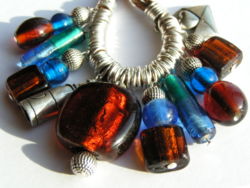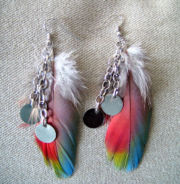
Figuring out how to price your designs is one of the least glamorous parts of
running a successful jewelry design business. Pricing your designs can be
tricky, especially if you design one of a kind pieces, but it is an essential
step you must take to turn your hobby into a profitable business. Once you
understand the costs of your business, and what you expect to profit from
your work, creating a formula to price your designs is a simple process.

1. Keep a "recipe book" to record exactly what was spent to create each
design. You will basically need to price each item used in your designs. For
example, if you pay $1.50 for a dozen sterling crimp beads, and you used 2
crimps beads in your design, you would divide $1.50 by 12 (12.5 cents per crimp
bead), and multiply by 2, totalling 25 cents for the crimp beads in this design.
This makes it much easier to calculate the exact cost of each design.
The more meticulous you are about calculating expenses, the better your pricing will be. Even the packing materials you use for the design and the shipping costs of the supplies should be accounted for. Keep receipts - this will also come in handy during tax time, if you want to deduct business expenses. Remember that materials cost is only one aspect of the costs involved in your designs.
2. Record your time spent on each design. How quickly can you design and complete your jewelry? Second to quality, speed is a key factor in profitability. If it takes you 30 minutes to recreate a design, you would charge differently than a design that takes 4-5 hours to create. Write your time spent in your recipe book. Decide how much you would need to pay a worker to do your job, and pay yourself at that rate. This is a vital aspect of the costs involved in your designs; don't ignore it!
Sooner than you think, you may decide to hire a friend to help you prepare for a show or party. The hourly wage paid to a worker, whether that person is you, or someone you hire, must be built into your price scheme, or you will not be able to remain in business. If you begin by charging $10 per hr for your work, and a necklace takes you 2 hours to make, you will add $20 to the materials cost of your necklace for your time. As you become more experienced, you will charge more for your skill and expertise.

3. Add Overhead and Profit. Everyone has a different method of calculating
their overhead costs, but there is ALWAYS some overhead. What is overhead?
Overhead covers a myriad of "hidden costs" and ignoring it is a fast way
to underprice yourself out of business.
When you first begin, overhead includes the shipping costs you pay to have your beads shipped to you, the investment you make every time you purchase a new pair of pliers, a work table, storage boxes, or price tags. Overhead includes every bead that rolled under the couch or down the street, and every item dropped in the grass during packing, or (sad, but it happens occassionally) stolen from your booth or table. It covers the cost of gas and insurance when you pick up tools and materials, and it covers all of the materials that get "used up" in the creation of your product, such as glue, solder, string, wire, coatings/finishes, etc.
It covers the time and cost of advertising, whether you spend time emailing your customers, or printing and mailing glossy postcards. It covers office expenses like business cards, computer paper and ink, packing slips, receipts, brochures, inventories, and more. Later on, overhead covers more expensive outlay of capital, such as rent, phone, computers, electric, heat, torches, gas, solder, flux, chemicals, and more expensive equipment to build your studio and your business.
Profit is what you add to your price to help your business grow. Profit is NOT the same as what you pay for labor. You may own your business and pay someone else to make all of the jewelry. They are paid for their labor, but the business still needs to make a profit, or it can't grow. Profit allows you to lay out the money for 3 strands of beads this week, when you could only afford two last week. Some calculations for profit and overhead can be complicated, but a quick and simple starting point is given below.
4. Calculate the price. Using a formula will give you a starting point, and you can tweak the price with the steps that follow. Which formula you use, however, will depend on whether you're selling retail (directly to customers) or wholesale (to stores, for example).

Wholesale - Take the total cost of your supplies plus your time,
multiply by 1.5 (some people multiply by 2). Multiplying by 1.5 - 2 covers
your overhead and profit to start with. You may adjust down if you are just
starting, and expenses are minimal, or up if you are actively building a larger business.
For example, if I am just starting and have low overhead, I may charge $8 per hr and take 1 hour to make a bracelet using $5 in materials; my price will be $5(mater.) + $8(time) = $13(cost) x 1.5 (overhd/profit) = $19.50 wholesale price. With more expensive equipment, more experience, and a product that requires a higher level of skill, I may charge $5 + 15/hr, x 2 = $40 wholesale. You can charge less for your jewelry if you're selling wholesale because you spend less time marketing to individual customers (advertising, processing orders, maintaining a shopping cart website, maintaining a store, etc.) and more time actually making jewelry.
You should verify that your market can afford a mark-up, using the next few steps. A wholesale operation will be selling your piece for around twice as much as you sell it to them. Many jewelry designers find that selling wholesale allows them to achieve business growth and profitability. When you use the 1.5 factor, you are allowing room for shop owners to sell your designs and even offer sales and discounts on your designs, if a certain design doesn't sell quickly enough. This may sound like a lot, but make sure that you consider the amount of time and labor you put into developing and creating your pieces as well as the boutique owner's expenses.
 Retail - Take the total cost of your supplies plus your time,
multiply it times 3 (or 4), and there's your retail price. This is the same
as wholesale x 2. A spreadsheet is perfect for this step. Simply set up a
table of products used, your time, and then a formula to calculate the
pricing using the 3 or other multiple.
Retail - Take the total cost of your supplies plus your time,
multiply it times 3 (or 4), and there's your retail price. This is the same
as wholesale x 2. A spreadsheet is perfect for this step. Simply set up a
table of products used, your time, and then a formula to calculate the
pricing using the 3 or other multiple.
Example: for the first example given above, I would simply multiply $19.50 (wholesale price) x 2, for a $39 retail price. In the second case, retail might be $40 x 2 + $80. There is a lot of room for adjustment here. If your business has a physical storefront, you have to take into consideration that there are additional costs. Rent, employee pay, utilities, displays and fixtures, and property taxes all need to be considered in your pricing strategy.
Even if you sell at a booth at a crafts market, you need to consider your transportation to and from the market, your time spent at the market, and all the supplies involved (tent, tables, food, signs, displays, bags, receipts, etc.). You may find that in your market, you need to price at 3 to 5 times your cost of materials plus time. This price allows you to cover the cost of buying your materials, paying (yourself or someone else) to make the pieces, selling them at wholesale with minimal overhead and profit covered (x 1.5 - 2), and then selling at retail yourself (2x wholesale), where a weekend booth at a moderately high end show may cost $500-$700.

5. Adjust for the cost of your labor. The difference between a hobby and
a business is whether you get a paycheck, so decide how much you want to
make per hour, and make sure that your labor is accounted for in the price.
Treat yourself as an employee who doesn't work for free. If you have
employees, consider the cost of paying them in addition to your own salary.
Let's say, for example, the cost of supplies for your design is $10. If you want to pay yourself $10 per hour and you spent 2 hours on this design, then you really need to be charging at least $60 for the piece ($10 supplies, $20 labor, $30 approximate overhead and profit, depending on wholesale or retail). There may be additional costs to consider, such as your storefront, or time spent marketing (e.g. creating a brochure).
• When deciding how much to pay yourself hourly, consider your experience. How long have you been designing jewelry? If you have a long track record, vast expertise, and a portfolio of unique designs, you may find that you can charge more. You may have particular advantages, including contacts, unique designs, high level skills, or ability to work with uncommon materials that allow you to charge more.
• To repeat - just because you enjoy doing the work doesn't mean you shouldn't get paid for it! Make sure you're getting at least minimum wage. If not, you may quickly decide that your time "just isn't worth it".
6. Perform market research. Now that you have an idea of what you want to charge for a design, it's time to dip your toes in the market and see if the piece can be profitable. Generally, it's a good idea to start off with the highest price you think the market will bear, because you can always bring it down. Have you visited craft shows, jewelry parties, and researched the web to see what work similar to yours is selling for?
• Have people offered to buy any of your jewelry designs? This is a good indication of the marketability of your designs. If your coworkers fight over a necklace you made, that may be a good sign that there is a market for your design. Friends and coworkers are also good sounding boards for prices. Ask them how much they think your design is worth, and what they would pay for it.
• Examine past success. Have you already sold any of your jewelry? This is important too in that it gives you concrete information on how much you can sell a design for. You may hear from friends of coworkers that they would pay $XX for a design, but an actual sale is real, concrete evidence.
• Has an experienced designer evaluated your work? Having the opinion of another designer can be valuable in determining the level of quality of your work, and what you can expect to get for it.
7. Re-evaluate the design. If you encountered feedback in the previous step which indicates that the price you arrived at isn't going to fly, you have some thinking to do about this design.
• If you do not find interest for a particular design, you may want to think of changing the design.
• Assess your materials. Do you design using sterling findings and semi-precious beads, or less expensive beads? Higher quality materials will always command a higher price in the market. You may want to consider making designs with both high quality materials, and less expensive materials. This will allow you to attract business from both the high end buyer, and the more budget minded buyer.
• Don't cut yourself short just to "break in" to the market (e.g. selling to customers at wholesale prices). This will only get people used to cheap prices, and it'll be difficult to raise them later on, jeopardizing your chances of ever making your business profitable. It's better to redesign or reject pieces that don't cover their costs as described above.
People are often suspicious of products sold at unusually low prices; most of us have internalized the idea that "you get what you pay for". Cheap prices are often interpreted as cheap materials and workmanship. If your pieces aren't selling well, try raising your prices. It goes against our intuition, but you may be surprised at the results!
Tips
• As you become more experienced, you'll find which prices cover your unique costs while still generating sales. For example, if you're doing a lot of beadwork and wirework where the supply cost is low but the time spent is high, and you're selling retail only through a website, the following could be a better formula:
• (cost of materials x 2) + (time spent on piece x hourly rate)
• calculate 30% of the previous figure and add it to the previous figure to account for overhead
• multiply the figure by 2 to get the retail price
• Some people use the tactic of setting a retail price just under a whole number ($49.95 rather than $50) to make the price look less intimidating. This may be more suitable for relatively inexpensive pieces but you should experiment to see how your customer base responds.
Article source: wikiHow wikiHow is a group effort to create a great resource: the world's largest free how to manual. wikiHow articles help people solve their everyday problems. wikiHow licenses all content under a Creative Commons License. The license allows wikiHow content to be used freely for noncommercial purposes. The Creative Commons License also allows for the creation of derivative works.
More Make Money With Crafts Ideas:
• Online Benefits for Craft Businesses
• How to Sell Crafts on Etsy
• Spice Up Your Craft Show Booth
• Choosing Arts and Crafts that are in Demand
• Making money with craft show customer service!
• How to Sell Crafts on Ebay
• Utilize a Craft and Antique Mall to Start your Business
• Tips For Turning Your Favorite Hobby Into a Successful Work-at-Home Business
• How to Profit from a Craft Niche
• Creating Charming Stuffed Animals from Socks

